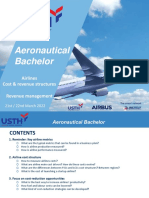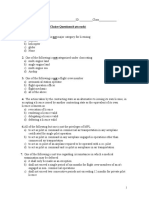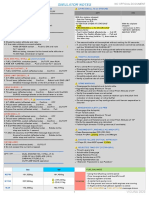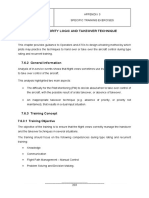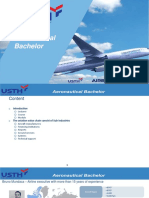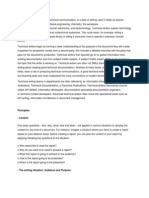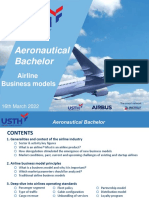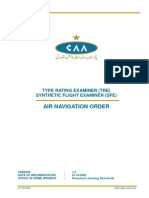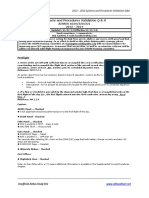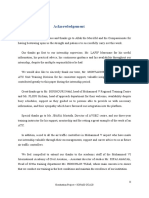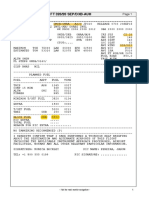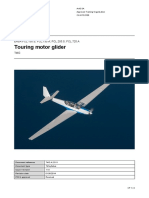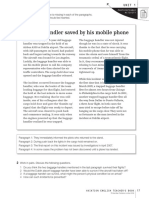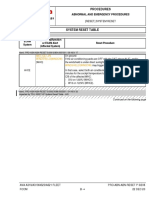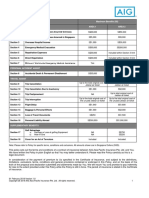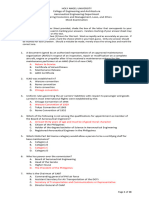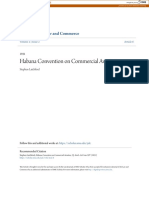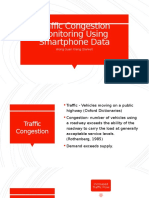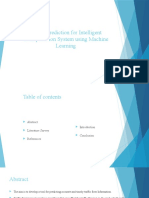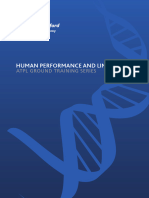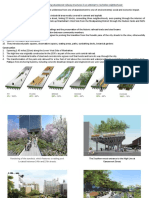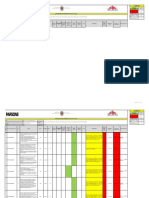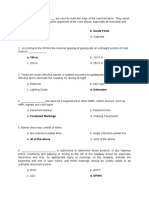0 ratings0% found this document useful (0 votes)
132 viewsPhase 1 Air Law Final Exam Key
Phase 1 Air Law Final Exam Key
Uploaded by
sadjuharThe document contains the key to a final exam on air law. It provides answers to 25 multiple choice questions covering topics such as the organizations formed by the Chicago Convention (ICAO), definitions of ICAO standards, pilot certification categories, aircraft type ratings for pilots, medical assessment durations, definitions of pilot licenses, aeronautical charts, right of way rules, visual meteorological conditions, airspace classes, and aircraft equipment requirements.
Copyright:
© All Rights Reserved
Available Formats
Download as DOCX, PDF, TXT or read online from Scribd
Phase 1 Air Law Final Exam Key
Phase 1 Air Law Final Exam Key
Uploaded by
sadjuhar0 ratings0% found this document useful (0 votes)
132 views6 pagesThe document contains the key to a final exam on air law. It provides answers to 25 multiple choice questions covering topics such as the organizations formed by the Chicago Convention (ICAO), definitions of ICAO standards, pilot certification categories, aircraft type ratings for pilots, medical assessment durations, definitions of pilot licenses, aeronautical charts, right of way rules, visual meteorological conditions, airspace classes, and aircraft equipment requirements.
Original Title
PHASE 1 AIR LAW FINAL EXAM KEY
Copyright
© © All Rights Reserved
Available Formats
DOCX, PDF, TXT or read online from Scribd
Share this document
Did you find this document useful?
Is this content inappropriate?
The document contains the key to a final exam on air law. It provides answers to 25 multiple choice questions covering topics such as the organizations formed by the Chicago Convention (ICAO), definitions of ICAO standards, pilot certification categories, aircraft type ratings for pilots, medical assessment durations, definitions of pilot licenses, aeronautical charts, right of way rules, visual meteorological conditions, airspace classes, and aircraft equipment requirements.
Copyright:
© All Rights Reserved
Available Formats
Download as DOCX, PDF, TXT or read online from Scribd
Download as docx, pdf, or txt
0 ratings0% found this document useful (0 votes)
132 views6 pagesPhase 1 Air Law Final Exam Key
Phase 1 Air Law Final Exam Key
Uploaded by
sadjuharThe document contains the key to a final exam on air law. It provides answers to 25 multiple choice questions covering topics such as the organizations formed by the Chicago Convention (ICAO), definitions of ICAO standards, pilot certification categories, aircraft type ratings for pilots, medical assessment durations, definitions of pilot licenses, aeronautical charts, right of way rules, visual meteorological conditions, airspace classes, and aircraft equipment requirements.
Copyright:
© All Rights Reserved
Available Formats
Download as DOCX, PDF, TXT or read online from Scribd
Download as docx, pdf, or txt
You are on page 1of 6
PHASE 1 FINAL EXAM KEY
Air Law
1. What organization was formed out of the Chicago Convention?
A. International Commission for Air Navigation (ICAN)
B. International Civil Aviation Organization (ICAO)
C. Joint Aviation Authority (JAA)
D. International Air Transport Association (IATA)
2. What does “standard” mean in reference to ICAO law?
A. It is a company’s Standard Operating Procedures approved by the authority.
B. Uniform application is necessary for the safety or regularity of civil aviation; compliance is
mandatory.
C. Uniform application is desirable, but not essential; application is not mandatory.
D. The use of the word “should” means that compliance is mandatory.
3. With respect to pilot certification, which is a category of aircraft?
A. Gyroplane, helicopter, airship, free balloon.
B. Airplane, rotorcraft, glider, lighter-than-air..
C. Single-engine land and sea, multi-engine land and sea.
D. Boeing 737, Airbus 320.
4. The pilot-in-command is NOT required to hold a type rating in which aircraft?
A. Aircraft certified for operation requiring at least two pilots
B. Helicopters and Power-lifts for single-pilot operations
C. To operate aircraft solely using instruments.
D. Whenever the licensing authority considers it necessary.
5. For MPL operations, a Class 1 Medical Assessment issued to a 25-year-old pilot on July 15 this
year, will expire
A. Midnight July 31, 12 months later.
B. Midnight January 14, 6 months later.
C. Midnight July 14, 12 months later.
D. Midnight July 14, 24 months later.
6. What is the duration of a Class 1 medical assessment issued to a 60-year-old pilot?
A. 6 months.
B. 12 months.
C. 18 months.
D. 24 months.
7. Which of the following is not a pilot license?
A. Private pilot
B. Commercial pilot
C. Instrument pilot
D. Airline Transport pilot
8. Refer to figure 1. Which marking indicates a taxiway/taxiway intersection hold position marking?
A. A
B. D
C. E
D. C
9. Refer to figure 2. What is indicated by “E”?
A. Displaced threshold
B. Stopway
C. Relocation of threshold
D. Clearway
10. Refer to figure 2. That portion of the runway identified by the letter “A” may be used for
A. Landing (touchdown)
B. Taxiing, takeoff and landing (touchdown)
C. Taxiing, takeoff and landing (rollout)
D. Taxiing only
11. Refer to figure 4. Illustration “A” indicates that the airplane is
A. below the glide slope.
B. on the glide slope.
C. Above the glide slope.
D. None of the above.
12. Aerodrome taxiway edge lights are identified at night by
A. white lights.
B. blue lights.
C. alternate yellow and green lights.
D. red lights.
13. Which aircraft has the right-of-way over all other air traffic?
A. Balloon
B. Aircraft in distress
C. Aircraft on final approach to land
D. Military aircraft
14. Which aircraft has the right-of-way over the other aircraft listed?
A. Glider
B. Airship
C. Airplane
D. Helicopter
15. What is the minimum safe altitude to operate an airplane over a populated area?
A. 500 feet
B. At an altitude that will allow a safe landing if an emergency occurs
C. 1000 feet
D. 1500 feet
16. The most effective method of scanning for other aircraft for collision avoidance during daylight
hours is to use
A. Regularly spaced concentration on the 3, 9 and 12 o’clock positions.
B. A series of short, regularly spaced eye movements to search each 10 degree sector.
C. Peripheral vision by scanning small sectors and utilizing off-center viewing.
D. Quickly scanning diagonally up/down and left/right.
17. “Empty Field Myopia” is
A. when flying at night, or at altitude above the clouds with no visual reference, with no definite
pattern on which to focus, the eye relaxes to a focus approximately 1 to 2 meters away.
B. a visual illusion created by staring at a light for several seconds, making the light appear to
move.
C. is another name for the visual blind spot created by the optic nerve being attached to the back
of the eye.
D. the phenomenon of the eye focusing at infinity when there is nothing close by on which to
focus.
18. When operating in Class A airspace, what is the maximum airspeed permitted?
A. 250 knots
B. No airspeed restriction
C. 200 knots
D. 300 knots
19. When operating VFR in Class D airspace below 10,000 feet MSL, what is the required flight
visibility?
A. 5 km
B. 10 km
C. 8 km
D. 3 km
20. What is the flight visibility requirement above 10,000 feet MSL in Class E airspace?
A. 8 km
B. 5 km
C. 10 km
D. 15 km
21. Flight plans must be submitted _____ before a flight.
A. 30 minutes
B. 1 hour
C. 90 minutes
D. 24 hours
22. What item does Ethiopia require to be filled out in the “Supplementary” section of a flight plan
form?
A. Aircraft endurance
B. Emergency equipment
C. Persons on board
D. Color of the aircraft
23. The Airworthiness Certificate is issued by the
A. State of Design
B. State of Manufacturer
C. State of Registry
D. ICAO
24. The Minimum Equipment List (MEL) allows the aircraft to be operated with
A. Missing equipment.
B. Inoperative equipment.
C. Repaired equipment.
D. Optional equipment.
25. Oxygen must be stored on aircraft to provide for pilots operating aircraft above 10,000 feet MSL
continuously.
A. True
B. False
1B
2B
3A
4C
5C
6A
7C
8C
9B
10 C
11 B
12 B
13 B
14 A
15 B
16 B
17 A
18 B
19 A
20 A
21 B
22 C
23 C
24 B
25 B
You might also like
- DMV Cheat Sheet California en Car PremiumDocument59 pagesDMV Cheat Sheet California en Car PremiumCAROLYN CANNONNo ratings yet
- Aeronautical Bachelor: Airlines Cost & Revenue Structures Revenue ManagementDocument51 pagesAeronautical Bachelor: Airlines Cost & Revenue Structures Revenue ManagementHà Ngọc ĐứcNo ratings yet
- Beyond Lion Rock The Story of Cathay Pacific Airways (Young, Gavin)Document300 pagesBeyond Lion Rock The Story of Cathay Pacific Airways (Young, Gavin)Emma ChanNo ratings yet
- Final Test For CAA MPLDocument8 pagesFinal Test For CAA MPLsadjuharNo ratings yet
- Preboard-MSTE Answer KeyDocument11 pagesPreboard-MSTE Answer KeyJae Han100% (2)
- Visual Approach Slope Indicator (VASI)Document20 pagesVisual Approach Slope Indicator (VASI)Duane Nico Estero Cawaling100% (1)
- Oimm (Shahid Hashemi Nejad Intl) - R (07jan16) PDFDocument36 pagesOimm (Shahid Hashemi Nejad Intl) - R (07jan16) PDFnabatmanNo ratings yet
- Flybe Group PLC FLYBGB Annual Report For Period End 31mar2015 English PDFDocument136 pagesFlybe Group PLC FLYBGB Annual Report For Period End 31mar2015 English PDFtheredcornerNo ratings yet
- Facilitator GuideDocument32 pagesFacilitator GuideForbetNo ratings yet
- Take Away 2 - Airbus Hazard Prevention Handbook (Distribution Copy)Document41 pagesTake Away 2 - Airbus Hazard Prevention Handbook (Distribution Copy)UbernatorNo ratings yet
- Operational Factors Human Performance - Attachment 16 - Rhoades Aviation Simulator Study Guide and CP Guidance - Redacted-RelDocument8 pagesOperational Factors Human Performance - Attachment 16 - Rhoades Aviation Simulator Study Guide and CP Guidance - Redacted-RelGFNo ratings yet
- Construct 2 Apps 18iws16Document15 pagesConstruct 2 Apps 18iws16Atul VasudevNo ratings yet
- BRIEFING (TYPICAL) - : Even If The Weather Improves Above The Defining CriteriaDocument5 pagesBRIEFING (TYPICAL) - : Even If The Weather Improves Above The Defining Criteriapiele70No ratings yet
- EOFDM WGA Runway Excursions-R1Document12 pagesEOFDM WGA Runway Excursions-R1UbernatorNo ratings yet
- Simulator NotesDocument2 pagesSimulator NotesJavier Castaños RuizNo ratings yet
- (Dual Input) Flight Crew Training Manual StandardsDocument8 pages(Dual Input) Flight Crew Training Manual StandardsLGTC 142No ratings yet
- AMC and GM To Part-ARA Amendment 6Document13 pagesAMC and GM To Part-ARA Amendment 6David WongNo ratings yet
- Flying Green - Executive DeckDocument33 pagesFlying Green - Executive Deckchristian.hatjeNo ratings yet
- Aeronautical BachelorDocument17 pagesAeronautical BachelorHà Ngọc ĐứcNo ratings yet
- Technical WritingDocument4 pagesTechnical WritingFrances Mae GerpacioNo ratings yet
- Unreliable Airspeed at TakeoffDocument10 pagesUnreliable Airspeed at TakeoffYves VenegasNo ratings yet
- Train The TrainerDocument144 pagesTrain The TrainerjaffersheriffNo ratings yet
- Aeronautical Bachelor: Airline Business ModelsDocument56 pagesAeronautical Bachelor: Airline Business ModelsHà Ngọc ĐứcNo ratings yet
- ACE Handout Apr 2022Document176 pagesACE Handout Apr 2022ChinsNo ratings yet
- Ano 026 LCXX 2.0Document51 pagesAno 026 LCXX 2.0Tariq khosoNo ratings yet
- Type Rating Full Course + Operator Conversion Course Airbus A350 (Hud) CODE: 350A1Document10 pagesType Rating Full Course + Operator Conversion Course Airbus A350 (Hud) CODE: 350A1pilotmoNo ratings yet
- MultiScan ThreatTrack™ Weather Radar UpgradeDocument2 pagesMultiScan ThreatTrack™ Weather Radar UpgradeGustavo PilatiNo ratings yet
- Greenland v50510Document1 pageGreenland v50510SnowlyNo ratings yet
- Instrument ProceduresDocument47 pagesInstrument Proceduresmarroco13No ratings yet
- Icao / Iata Losa Tem ConferenceDocument38 pagesIcao / Iata Losa Tem ConferenceRoberto LoboNo ratings yet
- Operational ProceduresDocument111 pagesOperational ProceduresJames MwamuyeNo ratings yet
- John C. Vassberg, Mark A. DehaanDocument22 pagesJohn C. Vassberg, Mark A. Dehaanfarah soufianeNo ratings yet
- Easa (Jaa) Atpl9Document27 pagesEasa (Jaa) Atpl9jcruzcanonNo ratings yet
- LFLB PDFDocument18 pagesLFLB PDFAnonymous scqhkCPxJFNo ratings yet
- 14POS06 - In-Flight Incapacitation - Flight Crew TrainingDocument2 pages14POS06 - In-Flight Incapacitation - Flight Crew TrainingpedatiNo ratings yet
- Competency-Based Uprt ProgrammesDocument10 pagesCompetency-Based Uprt ProgrammesAmgad Kamel MarzoukNo ratings yet
- GD04Document27 pagesGD04sofia muhammadNo ratings yet
- JAPANDocument38 pagesJAPANAhmed MsNo ratings yet
- Handouts Instrumentation 9 Autoflight IDocument29 pagesHandouts Instrumentation 9 Autoflight IpaulNo ratings yet
- Douglas DC 8 52 ZK NZBDocument31 pagesDouglas DC 8 52 ZK NZBGFNo ratings yet
- Quick Print Trip KitDocument113 pagesQuick Print Trip KitRadison sierraNo ratings yet
- UAAA - AlmatyDocument10 pagesUAAA - Almatyvlad pNo ratings yet
- Airbus SG2013 RC1Document24 pagesAirbus SG2013 RC1greatest everNo ratings yet
- UTAK - Turkmenbashi International (CAT B)Document4 pagesUTAK - Turkmenbashi International (CAT B)vlad pNo ratings yet
- Latest Pilot Jobs - List AtplquestionbankquizDocument77 pagesLatest Pilot Jobs - List AtplquestionbankquizmuratNo ratings yet
- Abnormal EmergencyDocument138 pagesAbnormal EmergencyFaiçal YoussfiNo ratings yet
- SOP EditedDocument107 pagesSOP EditedBrook EliasNo ratings yet
- Etops BDocument5 pagesEtops BBELISARIONo ratings yet
- A320 TR Flight OMDB - OMAA PDFDocument8 pagesA320 TR Flight OMDB - OMAA PDFMaalu ManoharNo ratings yet
- 1st Ath Workshop On EU965 2012Document88 pages1st Ath Workshop On EU965 2012Ahmet YikarbabaNo ratings yet
- Airport Icao Iata GCT (Deg) GCD (NM) : Dehradun, India Vidn/DedDocument9 pagesAirport Icao Iata GCT (Deg) GCD (NM) : Dehradun, India Vidn/DedsaurabhNo ratings yet
- IFATSEA FSF Presentation ATSEP and Uberlingen - OptDocument18 pagesIFATSEA FSF Presentation ATSEP and Uberlingen - OptFabio Benitez100% (1)
- Meteorology DatabaseDocument15 pagesMeteorology DatabaseLameck MwanzaNo ratings yet
- Crew Resource Management - CursDocument32 pagesCrew Resource Management - CursBă AnduleNo ratings yet
- Syllabus TMG 1-0 EASADocument30 pagesSyllabus TMG 1-0 EASAMarc RothNo ratings yet
- ICAO Model Repetitive Flight Plan (RPL) Listing Form: A2-12 Air Traffic Management (PANS-ATM)Document1 pageICAO Model Repetitive Flight Plan (RPL) Listing Form: A2-12 Air Traffic Management (PANS-ATM)Alejandra Lorenzo0% (1)
- Basic English Group ExercisesDocument10 pagesBasic English Group ExercisesMiran MirNo ratings yet
- Approved Training Organisations (ATO) in Der SchweizDocument17 pagesApproved Training Organisations (ATO) in Der SchweizHassane BAMBARANo ratings yet
- Computer ResetDocument206 pagesComputer Resetsent to youNo ratings yet
- Jetstar Policy WordingDocument14 pagesJetstar Policy WordingSoe Wai OkeNo ratings yet
- Quiz On Developing Price Strategies and Programs Name: Section: Date: ScoreDocument3 pagesQuiz On Developing Price Strategies and Programs Name: Section: Date: ScorebeverlybandojoNo ratings yet
- CPL Exams Ano 33Document36 pagesCPL Exams Ano 33Abdur RehmanNo ratings yet
- Answerkey EngrEcoLawsEthics - MockExamActivity-july 2019Document18 pagesAnswerkey EngrEcoLawsEthics - MockExamActivity-july 2019Lem TanhuecoNo ratings yet
- Part 7Document78 pagesPart 7sadjuharNo ratings yet
- Part 2Document335 pagesPart 2sadjuhar0% (1)
- EDDFDocument181 pagesEDDFsadjuharNo ratings yet
- Part 5Document56 pagesPart 5sadjuharNo ratings yet
- HECADocument29 pagesHECAsadjuharNo ratings yet
- HDAMDocument20 pagesHDAMsadjuharNo ratings yet
- QUIZ LAW 101 Air Law QuizDocument3 pagesQUIZ LAW 101 Air Law QuizsadjuharNo ratings yet
- Air Low ExDocument8 pagesAir Low ExsadjuharNo ratings yet
- Ip 13Document8 pagesIp 13sadjuharNo ratings yet
- ALW 101 Air Law Final Exam Answer Sheet KeyDocument1 pageALW 101 Air Law Final Exam Answer Sheet KeysadjuharNo ratings yet
- Habana Convention On Commercial Aviation: Journal of Air Law and CommerceDocument5 pagesHabana Convention On Commercial Aviation: Journal of Air Law and CommercesadjuharNo ratings yet
- Assessing Multimodal Freight Corridor Bottlenecks: Applications of CUBE To The Eastern Economic Corridor (EEC) in ThailandDocument36 pagesAssessing Multimodal Freight Corridor Bottlenecks: Applications of CUBE To The Eastern Economic Corridor (EEC) in ThailandSyǝd KhairiNo ratings yet
- Proposed Traffic Management Scheme For Liwasang Jose NDocument12 pagesProposed Traffic Management Scheme For Liwasang Jose NDominic Robiso DatuinNo ratings yet
- 2019 MazdaDocument8 pages2019 MazdalevanghvinjiliaNo ratings yet
- TitiDocument3 pagesTitiSasuke Uchicha100% (1)
- Traffic Congestion Monitoring Using Smartphone Data: Wong Guan Xiang (Daniel)Document5 pagesTraffic Congestion Monitoring Using Smartphone Data: Wong Guan Xiang (Daniel)Daniel WongNo ratings yet
- UP785356, U21337, Masterplan PDFDocument43 pagesUP785356, U21337, Masterplan PDFPatrick2108No ratings yet
- GS (2006) Vol 1 Rev25 S12 Traffic Signs, Road Markings and Road StudsDocument16 pagesGS (2006) Vol 1 Rev25 S12 Traffic Signs, Road Markings and Road StudsLap Chun TUNGNo ratings yet
- Traffic Prediction Using MLDocument7 pagesTraffic Prediction Using MLRavi Shankar0% (1)
- Road Space ContestationDocument98 pagesRoad Space ContestationnyonjecollinsNo ratings yet
- November 2008, Adelaide, South Australia 2008 Australasian Road Safety Research, Policing and Education Conference 815Document24 pagesNovember 2008, Adelaide, South Australia 2008 Australasian Road Safety Research, Policing and Education Conference 815Smith SongkhlaNo ratings yet
- Atpl 08 Human PerformanceDocument464 pagesAtpl 08 Human PerformancebryanpokNo ratings yet
- JMC Dotc and Dilg TransportDocument3 pagesJMC Dotc and Dilg TransportdennisvillasenorNo ratings yet
- DiscussionDocument8 pagesDiscussionShubhangi SinghNo ratings yet
- Traffic Engineering & ManagementDocument64 pagesTraffic Engineering & ManagementShriya KumariNo ratings yet
- Booklet - Inglés 6º CEIP Federico García LorcaDocument59 pagesBooklet - Inglés 6º CEIP Federico García LorcaAmeliaNo ratings yet
- 9th NotesDocument4 pages9th NotesJnv KhedaNo ratings yet
- Chapter 6: Traffic Count Database: 6.1 OverviewDocument76 pagesChapter 6: Traffic Count Database: 6.1 OverviewAfolabi OladunniNo ratings yet
- Brochure Concrete Safety Barriers A Safe and Sustainable ChoiceDocument17 pagesBrochure Concrete Safety Barriers A Safe and Sustainable Choicedario_791473996No ratings yet
- C-13, 2nd Floor, Paryatan Bhawan, Vipin Khand, Gomti Nagar, Lucknow - 226010Document199 pagesC-13, 2nd Floor, Paryatan Bhawan, Vipin Khand, Gomti Nagar, Lucknow - 226010ArstuNo ratings yet
- WMPR-Pulau Redang AirportDocument3 pagesWMPR-Pulau Redang AirportzulpandNo ratings yet
- NCHRP Syn 222Document105 pagesNCHRP Syn 222Rainer TafurNo ratings yet
- RS - 19BAR020 - 19BAR021 - Transportation System in ShimlaDocument9 pagesRS - 19BAR020 - 19BAR021 - Transportation System in ShimlaNityashree UttarwarNo ratings yet
- Action Plan For Close Out - 19122020Document5 pagesAction Plan For Close Out - 19122020jovindhaNo ratings yet
- Case StudyDocument19 pagesCase StudyMayvrick SangacenaNo ratings yet
- Legt PDFDocument13 pagesLegt PDFMiguel Angel MartinNo ratings yet
- PPL (A) Question BankDocument358 pagesPPL (A) Question BankCemalettin öztoprakNo ratings yet
- CEN-665 ETE Solution Spring 2021-22Document3 pagesCEN-665 ETE Solution Spring 2021-22JAYA RAWATNo ratings yet
- Group 8 Traffic Control EquipmentDocument6 pagesGroup 8 Traffic Control EquipmentChan OrsolinoNo ratings yet

